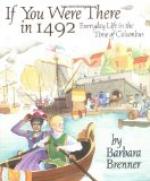Cape GUACIAS A Dios.
Steering along the coast of Honduras, on the 12th of September, he reached Cape Gracias a Dios, to which he gave this name in pious thankfulness for the southerly turn taken by the land at that point, so that the east winds, which had hitherto obstructed him, were now favourable to his course along the coast. A month later he entered several bays on the Isthmus of Panama, where he was able to procure provisions and to refit his vessels, but failed to obtain any intelligence either of the kingdom of the Khan, or of the strait which he fancied would lead him there. The natives whom he encountered were generally disposed to be friendly; but, in one instance, when the depth of water in a creek obliged him to moor his vessels close to the shore, an attack of the Indians was only repulsed by the use of artillery, the thunder and lightning of which seemed always to possess, in the eyes of the savages, a supernatural and therefore awful character. On another occasion, when a conference was held with one of the tribes, great alarm was caused by a notary, who attended to take notes of the conversation. The savages had never before seen the operation of writing; and they regarded it as a spell which was to have some magic effect upon them, and which they must neutralize by various mystic fumigations which they believed to act as counter-charms. “They were themselves skilled sorcerers,” says Columbus,—whose credulity in such matters was only that of his age.
Easterly course abandoned; the Bethlehem river.
It was not until the 5th of December that the admiral could resolve to abandon his easterly course, although the conviction had been gradually forcing itself upon him that the condition of his ships was such as to render a prosecution of his voyage almost impossible. He had scarcely turned back, intending to found a settlement on the river Veragua, before he encountered a storm which tried his worm-eaten caravels very severely. The thunder and lightning wore incessant; the waterspouts (the first they had seen) threatened to engulph them; huge crests of waves burst in phosphorescent floods over them; and their escape, if we consider the smallness of the caravels, and the force of a tropical cyclone, was little less than miraculous. At last, after eight days’ tossing to and fro, the admiral gained the mouth of a river, which he named the Bethlehem, because he entered it on the day of the Epiphany.
A settlement formed.
In this neighbourhood there was a powerful cacique, named Quibia, whose territory contained much gold, and with whom, therefore, the Spaniards were anxious to treat. But he outwitted them. Offering to supply them with guides to conduct them to his gold mines, he really sent them, not to his own mines, but to those of a rival cacique, of Urira. Here, however, they succeeded in acquiring, by barter and




